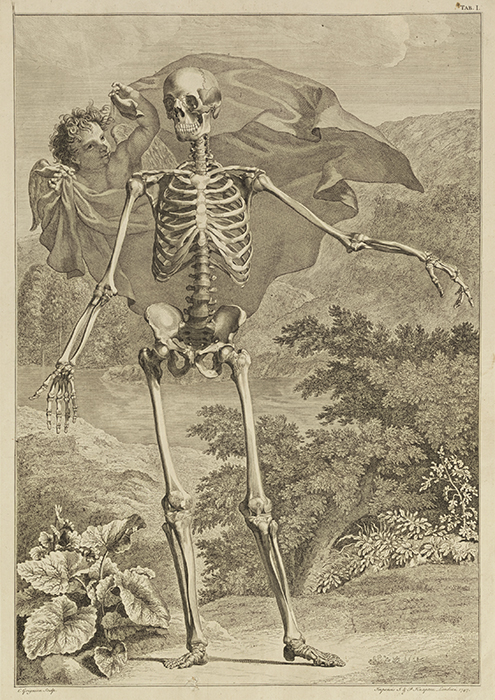
ALBINUS' SUPERB 1749 ANATOMICAL ATLAS, AMONG THE GREATEST ILLUSTRATED ANATOMICAL WORKS OF THE 18TH CENTURY, WITH PLATES "UNSURPASSED FOR THEIR BEAUTY AND SCIENTIFIC ACCURACY"
ALBINUS, Bernhard Siegfried. Tables of the Skeleton and Muscles of the Human Body. WITH: The Explanation of Albinus's Anatomical Figures of the Human Skeleton and Muscles. London: Printed by H. Woodfall, for John and Paul Knapton, 1749; 1754. Together, two volumes. Large atlas folio (20-1/2 by 27 inches), 20th-century three-quarter plum morocco; Explanation quarto, 20th-century three-quarter calf rebacked with original spine laid down, marbled boards. Housed in matching cloth slipcases. $27,000.
First edition in English of one of the most famous anatomical atlases of the 18th century, with 51 superb atlas folio copper-engraved plates (measuring approximately 18 by 26 inches), drawn and engraved by Jan Wandelaar. Together with the scarce separately published supplemental text volume, The Explanation of Albinus's Anatomical Figures, anonymously translated from Albinus' original Latin.
"Albinus' Tabulae sceleti et musculorum, based on his concept of the 'ideal man'… is among the most artistically perfect of anatomical atlases. Albinus and his artist Jan Wandelaar used some ingenious methods to prepare the illustrations… Wandelaar placed his skeletons and musclemen against lush ornamental backgrounds to give them the illusion of vitality, using contrasts of mass and light to produce a three-dimensional effect. The most famous plate in the atlas depicts a skeletal figure standing in front of an enormous grazing rhinoceros, sketched by Wandelaar from the first living specimen in Europe, which had arrived at the Amsterdam zoo in 1741. Because the rhinoceros had not been portrayed in European art from a living example until the arrival of the Amsterdam specimen, Albinus and Wandelaar adopted the creature as a symbol of their atlas, which depicted the human body" (Norman Library 29).
"The chef d'oeuvre of Albinus, professor of surgery at Leiden, with illustrations of the bones and muscles unsurpassed for their beauty and scientific accuracy. The amazing plates in this work were drawn and engraved by Jan Wandelaar… Albinus supervised every drawing with meticulous care, and saw that the smallest details were reproduced with the greatest accuracy. This magnificent work is the apogee of a remarkable collaboration between physician and artist which lasted over thirty years. The first three plates are finished representations of the skeleton and are each accompanied by an outline plate of the same size. The following nine plates represent complete finished musclemen, each with an additional outline plate. The fourteen plates following these represent special muscles and parts of muscles. Each one of the very numerous figures on these last fourteen plates is supplied with an outline drawing unless the letters are engraved directly above the finished figures. There is a total of forty plates. The first twelve plates are some of the most beautiful plates in the history of engraving. Wandelaar placed each in a carefully chosen landscape setting, and the artistic results are so pleasantly successful that the anatomical figures, although composed in many separate parts, appear to be actually stepping out of the picture" (Norman, Medicine and the Life Sciences). The plates "established a new standard in anatomical illustration and remain unsurpassed for their artistic beauty and scientific accuracy" (Garrison-Morton, 5th ed., 399). This is the first edition in English, complete with 40 copperplate engravings. This copy has been bound with Albinus' edition of Eustachius' A Compleat System of the Blood-Vessels and Nerves (London, 1750), which contains 11 additional plates. The two works were often bound together, as the second work is considered a supplement to the first. The first edition of Albinus' atlas, also with 40 engraved plates, was published in Leiden in 1747 in Latin; the second Latin edition was published in London in 1749 by the Knaptons, who published this first English translation later that same year. Choulant/Frank 27683. See Garrison-Morton 399; Norman 29; Wellcome II, 26. Contemporary ink owner signature to title page of Explanation.
Atlas folio with closed tear to first title page repaired on verso; small closed tear to third title page, just affecting imprint. Text and plates generally quite clean. Expert restoration to spine ends, binding sound and attractive. Quarto text volume with occasional foxing. A near-fine copy of this scarce and desirable work.